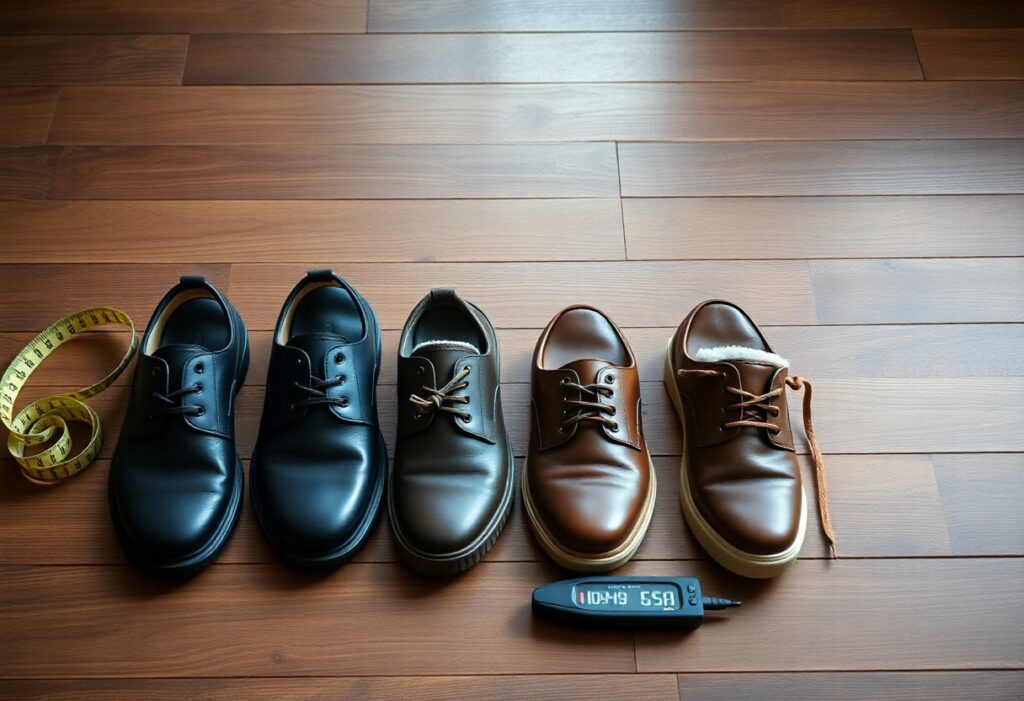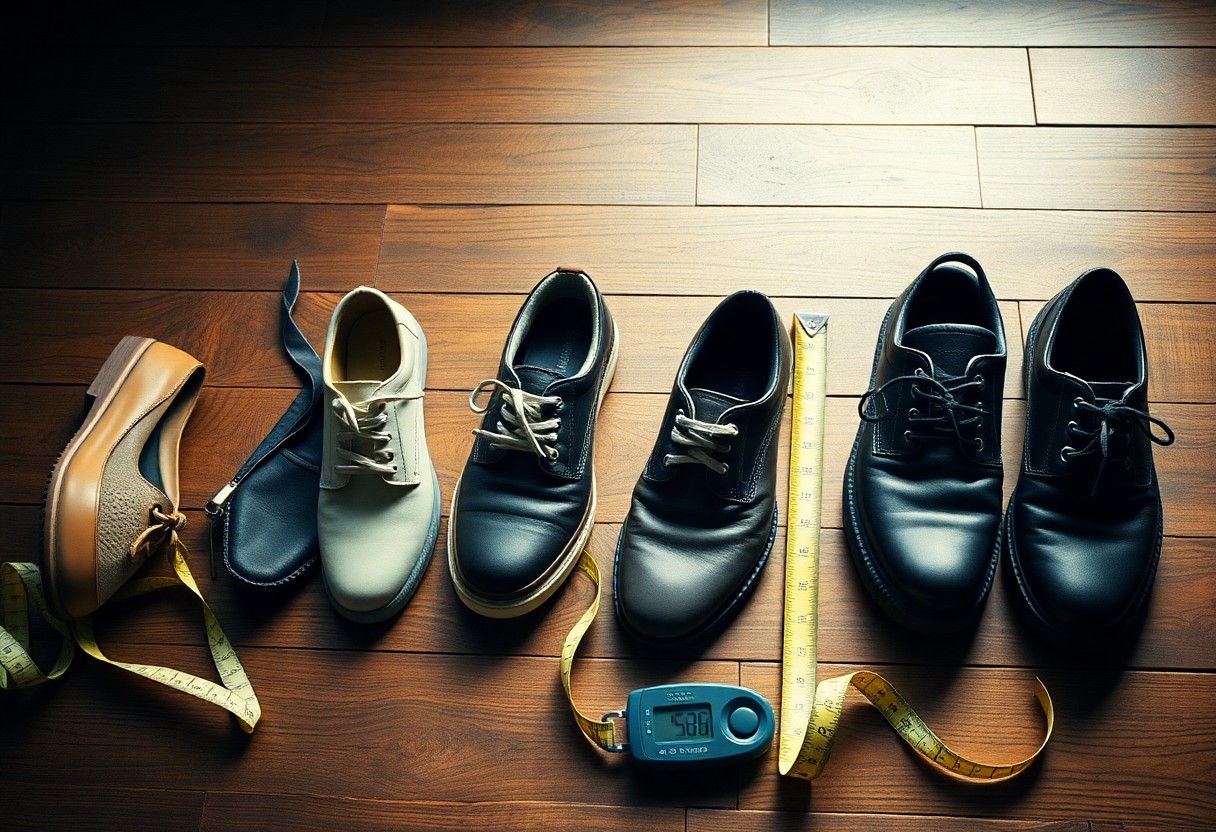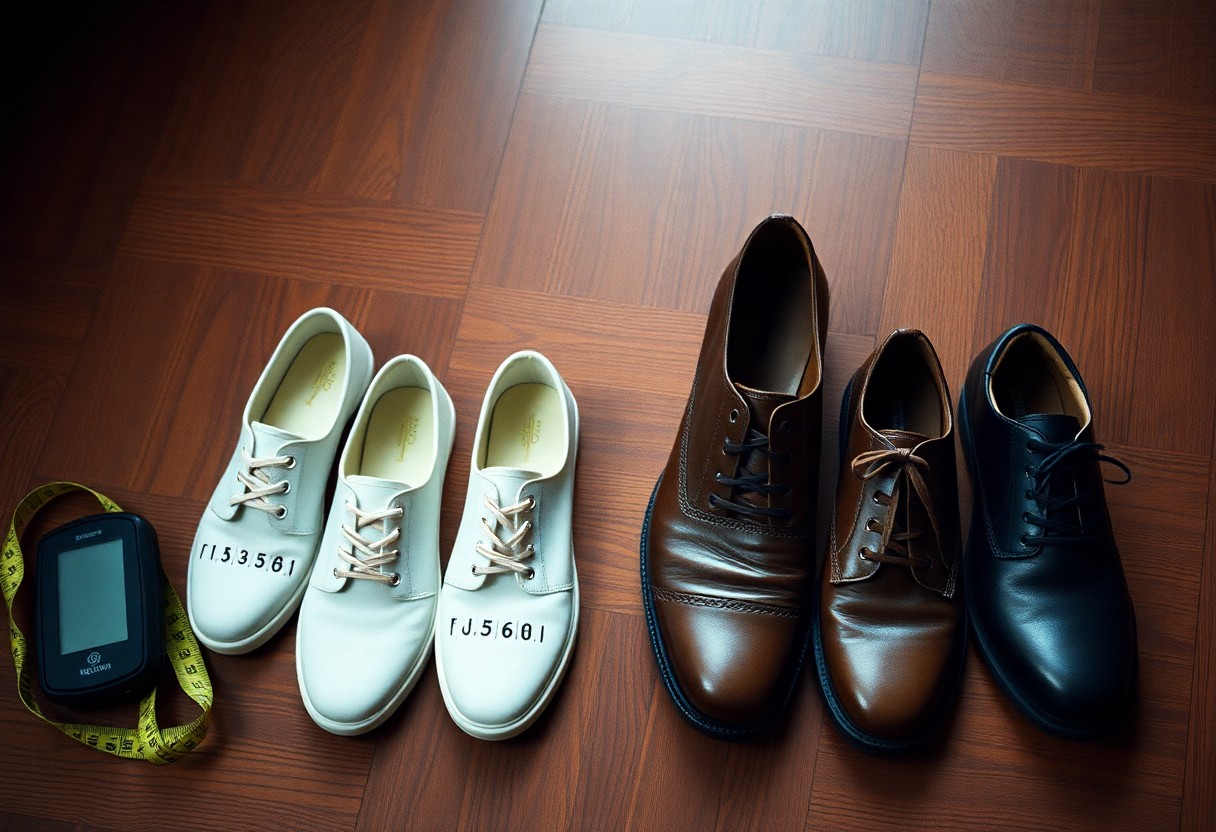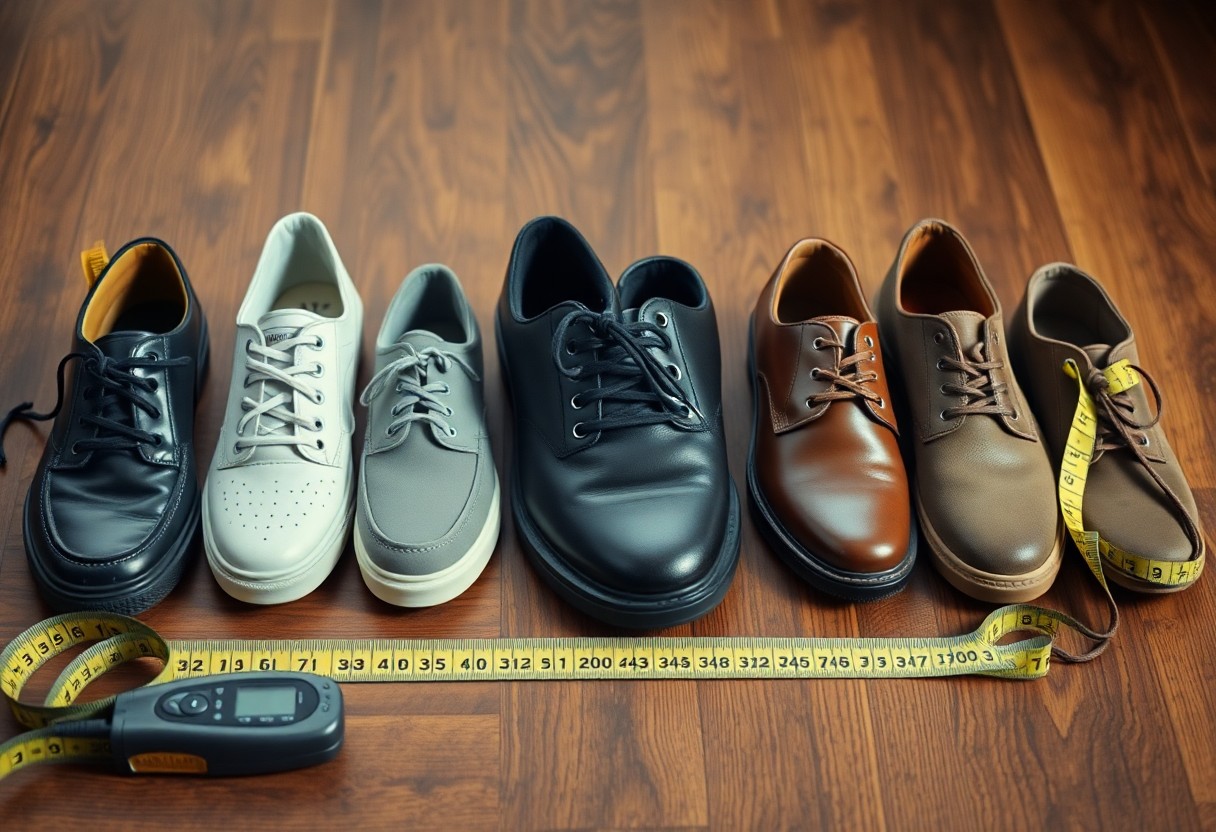
Recognizing the significance of selecting shoes with the appropriate width is crucial for preserving your overall foot health and comfort. Wearing shoes that fit well can greatly mitigate foot pain and help avoid serious health issues. When you shop for footwear, it’s vital to take into account both the length and width of the shoes to guarantee a perfect fit. Opting for shoes with the correct width not only improves your balance and blood circulation but also lowers the risk of developing blisters and other foot-related problems. To find your ideal shoe width, measure the broadest part of your foot and consult standardized width charts. Many individuals mistakenly emphasize length, neglecting that proper width is equally essential for daily comfort and long-term foot health.
Master the Art of Measuring Your Feet for the Perfect Shoe Fit
The most reliable approach to determine your shoe width is to measure your feet later in the day when they are likely to be at their most swollen state. Foot width can vary by as much as half an inch throughout the day, making evening measurements the most dependable for achieving a proper fit. To do this accurately, stand on a sheet of paper and trace around your foot, ensuring you capture the most precise measurement possible. This straightforward yet effective technique can help you find footwear that not only fits well but also delivers the necessary comfort and support for your feet throughout the day.
Proven Techniques for Accurately Measuring Foot Width
Beyond using a standard ruler, consider the benefits of a Brannock Device, a specialized instrument found in most shoe stores that accurately measures foot size and width. This tool allows you to measure the widest part of your foot, which is usually across the ball area. For optimal accuracy, it’s essential to take measurements of both feet while standing, as most people have one foot that is slightly larger than the other. By doing so, you can ensure that you select shoes that fit comfortably on your larger foot, thereby preventing discomfort during wear and enhancing your overall experience.
Avoiding Common Pitfalls When Choosing Shoe Width
One of the most frequent mistakes made when selecting shoe width is underestimating the importance of accurate width measurements. Many individuals focus solely on the length, which can lead to discomfort and a myriad of potential foot issues. Other common errors include measuring feet while seated and mistakenly assuming that your foot width remains constant throughout your life. It’s important to understand that wearing shoes that are too narrow can result in significant foot complications such as bunions, corns, and hammertoes. Foot size can change due to various factors, including weight gain, pregnancy, or aging, which is why it’s advisable to measure your feet annually. Choosing the right width can help prevent blisters, calluses, and chronic foot pain, ensuring you maintain excellent foot health.

Decoding Shoe Width Systems and Standards for the Best Fit
Gaining a solid understanding of the various shoe width systems is essential for ensuring comfort and foot health. Different brands and countries utilize distinct measurement standards, so being knowledgeable about these systems can aid you in selecting shoes that fit correctly and prevent foot-related issues. By understanding how width is categorized, you can make informed decisions when choosing footwear that meets your specific requirements.
Understanding Letter-Based Width Scales for Optimal Shoe Fit
When shopping for shoes, you will generally encounter widths labeled from AA to EE. For women, a standard medium width is designated as B, whereas for men, it is D. Narrow widths are classified from AA to B, while wide widths extend from D to EE. This letter-based classification system is designed to assist you in identifying the appropriate fit based on your foot shape, ensuring that your shoes feel comfortable and provide the necessary support throughout the day.
International Width Measurement Standards and Their Significance
When navigating the global market for footwear, you may encounter various measurement systems. For instance, European sizes are determined by millimeters, while UK sizes adhere to their own width standards. Your US shoe size may vary from international measurements by one to two width sizes. Therefore, it is critical to always consult the brand’s size chart when purchasing shoes from international retailers. Japanese shoes are often narrower, while European brands typically offer a wider toe box. To ensure the best fit, measuring your feet in millimeters provides the most accurate reference for international purchases, helping you avoid fitting issues.

Understanding How Shoe Construction Influences Fit and Comfort
To make informed footwear choices, it’s essential to grasp how the construction of shoes impacts fit and comfort. The design and assembly of a shoe significantly affect how it fits and feels on your foot. Your comfort is heavily influenced by the connection between the upper part of the shoe and its sole, as well as the flexibility of the materials around the widest part of your foot. By selecting shoes with thoughtful construction, you can greatly enhance your comfort and support, leading to a more enjoyable wearing experience.
The Advantages of Natural Materials in Footwear
Shoes crafted from genuine leather offer remarkable breathability and adaptability. Leather naturally stretches and conforms to your foot shape over time, resulting in a customized fit that enhances comfort. Studies have shown that leather shoes can expand by up to 30% of their original width, making them an excellent option for individuals with varying foot widths seeking both comfort and flexibility in their footwear choices.
Durability and Consistency of Synthetic Shoe Materials
Modern synthetic materials provide consistent width measurements and impressive durability. These materials protect your feet while also delivering water resistance and improved breathability. Many synthetic shoes now integrate mesh panels that enhance airflow and flexibility, allowing for better movement. Moreover, advancements in synthetic materials have led to the incorporation of comfort features like memory foam and gel inserts, which provide targeted cushioning and support. Recent research indicates that synthetic materials can maintain their shape up to 40% longer than traditional materials, ensuring your shoes retain their appropriate width throughout their lifespan.

Recognizing Signs of Proper Shoe Width for Maximum Comfort
Unlike shoe length, the correct shoe width is apparent in how your feet feel and function while wearing them. Your shoes should allow your toes to spread naturally while walking, with approximately half an inch of space at the widest part. Research indicates that 70% of people wear shoes that do not fit properly in width, leading to various foot problems. Being able to recognize the signs of proper width can significantly enhance your footwear choices and overall foot health.
Critical Indicators of Comfort from Proper Shoe Width
Here are key indicators that your shoes fit correctly in terms of width: your toes should be able to wiggle freely, the ball of your foot should align with the widest part of the shoe, and there should be no pinching sensation on the sides. A well-fitting shoe allows your feet to expand comfortably throughout the day, as research shows that feet can swell by up to 8% by the end of the day, necessitating proper width for all-day comfort.
Identifying Warning Signs of Incorrect Shoe Width
It’s crucial to monitor for warning signs during regular wear, such as numbness or tingling in your toes, blisters on the sides of your feet, and indentations on your skin after removing your shoes. These symptoms indicate that your shoes may be too narrow or excessively wide for your feet. Proper width is vital for maintaining foot health, as studies show that ill-fitting shoes can lead to long-term foot issues. You should not experience any pressure points while standing or walking; if you notice pain, redness, or if your foot spills over the edges of the shoe, it’s time to reassess your width choice.
Understanding Width Variations Among Shoe Brands
Many shoe manufacturers provide a range of width options, from AA (super narrow) to 4E (extra wide). It's important to recognize that foot width can change throughout the day, and research indicates that up to 70% of individuals have different widths between their left and right foot. Understanding these variations will empower you to choose shoes that cater to your unique foot shape, avoiding discomfort and potential foot complications.
The Influence of Brand Differences on Shoe Width Measurements
When comparing different brands, you may observe significant discrepancies in width measurements. A medium width in one brand may feel narrow in another. European brands often run narrower compared to American brands, while athletic footwear companies usually offer the widest range of options. It’s always advisable to try on shoes before purchasing them, as size perception can vary across different manufacturers.
The Role of Shoe Style in Width Fitting
The style of the shoe is crucial in determining how width fits your foot. Athletic shoes typically provide more flexibility in width compared to dress shoes, whereas sandals are designed to accommodate a more natural foot width. Your width requirements may vary based on the shoe’s intended purpose and the activities you plan to partake in. Further analysis reveals that specific styles necessitate particular width considerations. For example, high heels require a secure fit to prevent slipping, while work boots may need additional width for accommodating thicker socks comfortably. Running shoes should provide approximately half an inch of space between your longest toe and the shoe’s tip for optimal comfort and performance.
Identifying Special Width Requirements for Unique Foot Conditions
While standard sizing options exist, certain individuals may need specific width accommodations. If you suffer from conditions like bunions, flat feet, or experience swelling, you might find that wider shoes are necessary. Additionally, your foot width can vary throughout the day, with studies suggesting a possible 4% increase in foot volume by evening. Recognizing these fluctuations is essential for selecting shoes that remain comfortable throughout your daily activities.
Medical Conditions That Require Special Width Accommodations
Special width requirements often stem from medical issues. For those with diabetes, arthritis, or edema, it’s crucial to have shoes that offer extra width allowance for improved circulation. Healthcare professionals may recommend specific width measurements to help prevent complications associated with these conditions. Studies indicate that 75% of individuals with foot conditions benefit from specialized width fittings, highlighting the importance of selecting the right footwear for optimal foot health.
Activity-Specific Width Requirements for Enhanced Performance
An active lifestyle necessitates different shoe widths depending on the activity. For instance, your running shoes may require more width than casual footwear, while hiking boots need extra space to comfortably fit thick socks. Athletes often benefit from shoes that are half a size to a full size wider for high-impact activities, allowing for necessary foot expansion during intense performance. When considering activity-specific fitting, be mindful of your foot’s natural movement patterns. During running, your feet can expand up to half a size wider. For sports involving lateral movements, such as tennis or basketball, adequate width is essential to avoid foot strain and potential injuries. Your footwear choices should align with your activity levels and unique foot characteristics to ensure maximum comfort and performance.
Discovering Your Ideal Shoe Width for Enduring Comfort
The key to finding your perfect shoe width lies in understanding proper measurement techniques and the range of width options available. By measuring your feet at their widest point, knowing your width category (ranging from A to E), and selecting shoes that match your measurements, you can ensure lasting comfort. Your shoes should fit snugly without causing pinching or sliding, allowing your toes the freedom to move naturally. By making the right width choice and selecting materials that cater to your foot’s needs, you can enjoy comfortable, well-fitting footwear that supports your daily activities and lifestyle.
Your Top Questions Answered About Shoe Width
Q: How do I measure my foot width accurately at home?
A: To measure your foot width at home, place your foot on a blank sheet of paper and trace its outline. Measure the widest part, typically at the ball of your foot, using a ruler. It’s best to take these measurements in the afternoon when your feet are at their largest. Don’t forget to measure both feet, as one may be wider than the other. Use these measurements to refer to shoe width charts provided by different manufacturers to find the best fit for you.
Q: What are the standard width measurements for shoes?
A: Shoe widths generally utilize letter codes ranging from A to E. For women, the standard medium width is B, while for men, it’s D. Narrow widths are designated by A and AA, while C and D indicate medium-wide for women. E and EE represent wide widths. Keep in mind that each brand may have slight variations in their width measurements, so it’s wise to check their specific size charts before making a purchase.
Q: How can I tell if my current shoes are the wrong width?
A: Look for indicators such as red marks on the sides of your feet, numbness in your toes, blisters on your heels or sides, and shoes that slip off while walking. Your toes should have ample space to wiggle freely, and the ball of your foot should fit comfortably at the widest part of the shoe. If you experience pressure on the sides, it may be time to consider a wider shoe. Conversely, if your foot shifts side-to-side in the shoe, you may need a narrower fit.
The Article How to choose the right shoe width tips for a comfortable fit appeared first on My Shoes Finder
The Article Choosing the Right Shoe Width for Ultimate Comfort Was Found On https://limitsofstrategy.com


You know, I’ve always thought shoe shopping was just an excuse to explore the depths of my wallet, but now I see it’s a mission to protect my precious foot soldiers! Your emphasis on width strikes a chord with me. I’ve definitely been that person who buys shoes thinking, “Length is king,” only to end up with bruised toes and a cursed arch. It’s like trying to squeeze a sausage into a too-tight casing—inevitably, someone ends up getting hurt!
I get where you’re coming from—shoe shopping can feel like this slippery slope into a wallet-emptying abyss. But when you start seeing it as a mission for your foot soldiers, it becomes a bit more rewarding, right? Your feet really do a lot of heavy lifting for us, so treating them with care should be top of mind.